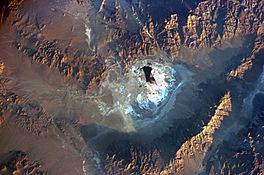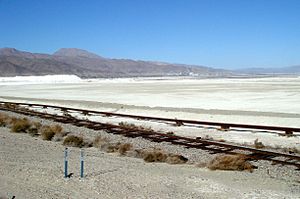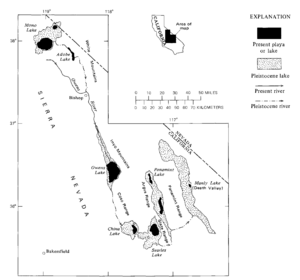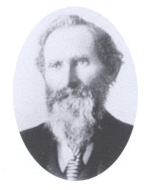Searles Lake facts for kids
Quick facts for kids Searles Lake |
|
|---|---|

|
|
| Lua error in Module:Location_map at line 420: attempt to index field 'wikibase' (a nil value). | |
| Location | Searles Valley, Mojave Desert San Bernardino County, California |
| Type | Endorheic basin |
| Primary outflows | Terminal (evaporation) |
| Basin countries | United States |
| Max. length | 19 km (12 mi) |
| Max. width | 13 km (8.1 mi) |
| Shore length1 | 50 km (31 mi) |
| Surface elevation | 493 m (1,617 ft) |
| Settlements | Trona, California |
| 1 Shore length is not a well-defined measure. | |
Searles Lake is a dry lake located in the Searles Valley of the Mojave Desert in northwestern San Bernardino County, California. It's called an endorheic lake because water flows into it but doesn't flow out to the ocean; it only leaves by evaporation. In the past, people also called it Slate Range Lake or Borax Lake.
The town of Trona is right on its western side. This dry lake is about 19 kilometers (12 miles) long and 13 kilometers (8 miles) wide. It's a very important place for mining industrial minerals. Companies here dig up about 1.7 million tons of minerals every year! Searles Lake is surrounded by the Argus and Slate Mountains. The lake was named after John Wemple Searles, who discovered borax here.
Contents
The Lake's Past and Geology
The ground under Searles Lake tells a story about its past. It shows that the lake once held salty water as deep as 200 meters (656 feet). The water levels changed a lot over time. These changes happened when glaciers in the Sierra Nevada mountains grew and then melted.
Over the last 150,000 years, the lake had 30 major periods of high and low water. When the lake water evaporated, it left behind layers of salt and mud. This is how many valuable minerals formed in the lake bed.
The lake is also home to the Trona Pinnacles. These are amazing rock formations made of tufa, which is a type of limestone. They are so special that they are a National Natural Landmark.
| Searles Lake Borax discovery | |
|---|---|

Trona, California, abuts northwest of the dry Searles Lake bed.
|
|
| Location | Trona Rd at Center St., San Bernardino, California |
| Designated | August 16, 1962 |
| Reference no. | 774 |
| Lua error in Module:Location_map at line 420: attempt to index field 'wikibase' (a nil value). | |
History of Mining
Borax was first found and mined from the dry surface of Searles Lake in 1873. A man named John Searles discovered it. He and his brother Dennis started the San Bernardino Borax Mining Company. They ran the company until 1897.
John Searles was famous for using the 20 mule team wagons. These teams hauled the refined borax. In 1873, before railroads reached the area, the 20 mule teams carried borax 175 miles. They went from what was then called Slate Range Playa (now Searles Lake) all the way to the harbor in San Pedro.
The discovery of borax at Searles Lake is so important that it's a California Historical Landmark. There's a special plaque at a rest area in Trona to mark this spot. From 1922 to 1928, a unique Epsom Salts Monorail even crossed Searles Lake on a wooden bridge!
Minerals and Mining Today
Searles Lake is like a giant treasure chest of minerals. It has huge amounts of sodium and potassium minerals. These include types like carbonates, sulfates, borates, and halides.
Mining these minerals is a complex process. Companies pump naturally salty water, called brine, from deep wells. These wells can go down over 100 meters (328 feet) into the salt beds. A network of wells, pipes, and special ponds helps to collect and treat these brines.
The minerals are taken out of the brines at three different plants: Argus, Trona, and Westend. The minerals are crystallized from the brines. Then they are cleaned, washed, and dried. Sometimes, they are even baked in large ovens to remove water.
Searles Valley Minerals, the company operating here, produces many useful things. These include borax, boric acid, soda ash (used in glass and detergents), salt cake (used in paper and detergents), and regular salt. There are over four billion tons of minerals estimated to be in Searles Lake!
Trona Pinnacles
The Trona Pinnacles are a special natural area. They are part of the California Desert National Conservation Area. The Bureau of Land Management helps protect and manage this unique place.
Historical Markers
There are special markers that tell the story of Searles Lake.
California Historical Landmark Marker
The marker for California Historical Landmark #774 says:
- NO. 774 SEARLES LAKE BORAX DISCOVERY - John Searles discovered borax on the nearby surface of Searles Lake in 1862. With his brother Dennis, he formed the San Bernardino Borax Mining Company in 1873 and operated it until 1897. The chemicals in Searles Lake-borax, potash, soda ash, salt cake, and lithium-were deposited here by the runoff waters from melting ice-age glaciers, John Searles' discovery has proved to be the world's richest chemical storehouse, containing half the natural elements
E Clampus Vitus Monument
A monument was placed by the E Clampus Vitus group to honor the Searles brothers. The marker reads:
- "This monument commemorates two wagon routes used by the Searles brothers to haul borax from their plant on Borax Lake (now Searles Lake) to the railhead at Mojave. The southern route traveled west of the Trona Pinnacles to Searles' freight station at Garden City. This is the present route of the Trona Railway which connects with the Union Pacific at Searles Station. Garden City was a virtual oasis, providing food and shelter for the teamsters and a barn accommodating 100 mules. The western route went through Salt Wells Canyon (Poison Canyon) to a dry station one mile from the head of the canyon and on to garden City where both routes joined. It then continued through Garlock and connected with the road to Mojave. Erected 2000 by Billy Holcomb Chapter No. 1069, E Clampus Vitus in cooperation with Searles Valley Historical Society."





